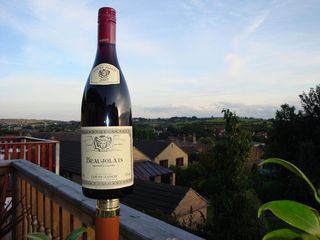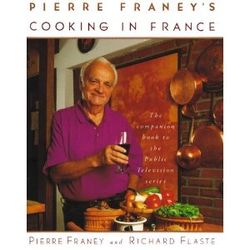I read with interest this morning the New York Times obit on Marcel Lapierre, the 60-year-old Frenchmen generally credited with improving the image (and the quality) of Beaujolais wines.
 I know just what you’re thinking. Beaujolais? Eeeeeew. How pedestrian.
I know just what you’re thinking. Beaujolais? Eeeeeew. How pedestrian.
(This cool photo is from a Web site called “Confessions of a Wino.”)
It’s a pity that this lovely wine is so misunderstood. Most connoisseurs appreciate the charms of the Gamay grape. But many wine drinkers don’t know much about it, and wine snobs dismiss it as something that’s released each year with tacky hoopla as “Nouveau” on the third Thursday in November. Indeed, the contrived frenzy over Nouveau Beaujolais turned off a lot of potential fans over the years, as did a couple of whopper scandals in the industry. But today, the Beaujolais region is turning out impressive wines with remarkably low pricetags.
I personally like the stuff. The real Beaujolais, not the Nouveau. The more elegant crus. Read on.
To be fair, all Beaujolais is not created equal. There are 12 main appellations covering wine production in some 100 villages in the Beaujolais region. The most basic appellations are Beaujolais and Beaujolais-Villages. These are light-bodied wines with fairly high levels of acidity, minimal tannins, ripe berry aromas and intense red and black fruit flavors. They rarely have higher than 12.5 percent alcohol. They’re usually served slightly chilled and meant to be drunk young, with hearty food, lusty conversation and ample laughter. Two of the best known producers are Louis Jadot and Georges Duboeuf. Prices of these wines hover around the $10 mark.
The next level of Beaujolais, the crus, the more 'serious' wines, are made in villages that have their own appellations. These include Brouilly, Julienas, Regnié, Fleurie, Morgon and Moulin-a-Vent. They are more sophisticated wines and more likely to be made in the style of the famous Burgundies (Pinot Noir) from further north. While still deliciously “gulpable,” these wines are more complex with lovely cherry and raspberry notes, floral overtones and a bit of spice. The crus are generally in the $15 to $22 range.
I, too, had one foot in the naysayer camp decades ago, but ever since an enlightening dinner at Le Cirque some 20 years ago I’ve been a fan.
 My husband and I were dining at the revered New York City temple of haute cuisine with Pierre Franey. one of the trailblazers who brought fine French food to New York City and the U.S. in the ‘40s and 50s, and who went on to become a prolific cookbook author and New York Times columnist.
My husband and I were dining at the revered New York City temple of haute cuisine with Pierre Franey. one of the trailblazers who brought fine French food to New York City and the U.S. in the ‘40s and 50s, and who went on to become a prolific cookbook author and New York Times columnist.
Chef Daniel Boulud was in the kitchen in those days, preparing trend-setting fare that was both elegant and exciting. (That night’s sea bass prepared with a scalloped jacket of paper-thin potato slices, and the scallop in “black tie” are still at the top of my all-time-greats list.)
When the sommelier presented me with the wine list, I deferred to Franey. With some trepidation I might add. I was paying the bill and Le Cirque’s wine list was notorious for triple- and quadruple-digit price tags. After a brief survey of the list, Franey declared enthusiastically, “Brouilly. I love a good Beaujolais.”
And it was with that “good Beaujolais” that I enjoyed one of the most memorable dinners of my career. To this day, I get a craving for the food-friendly wine every now and then. And I always raise my glass in a toast to my friend Pierre Franey, one of the food world’s least pretentious and most influential personalities.

Comments